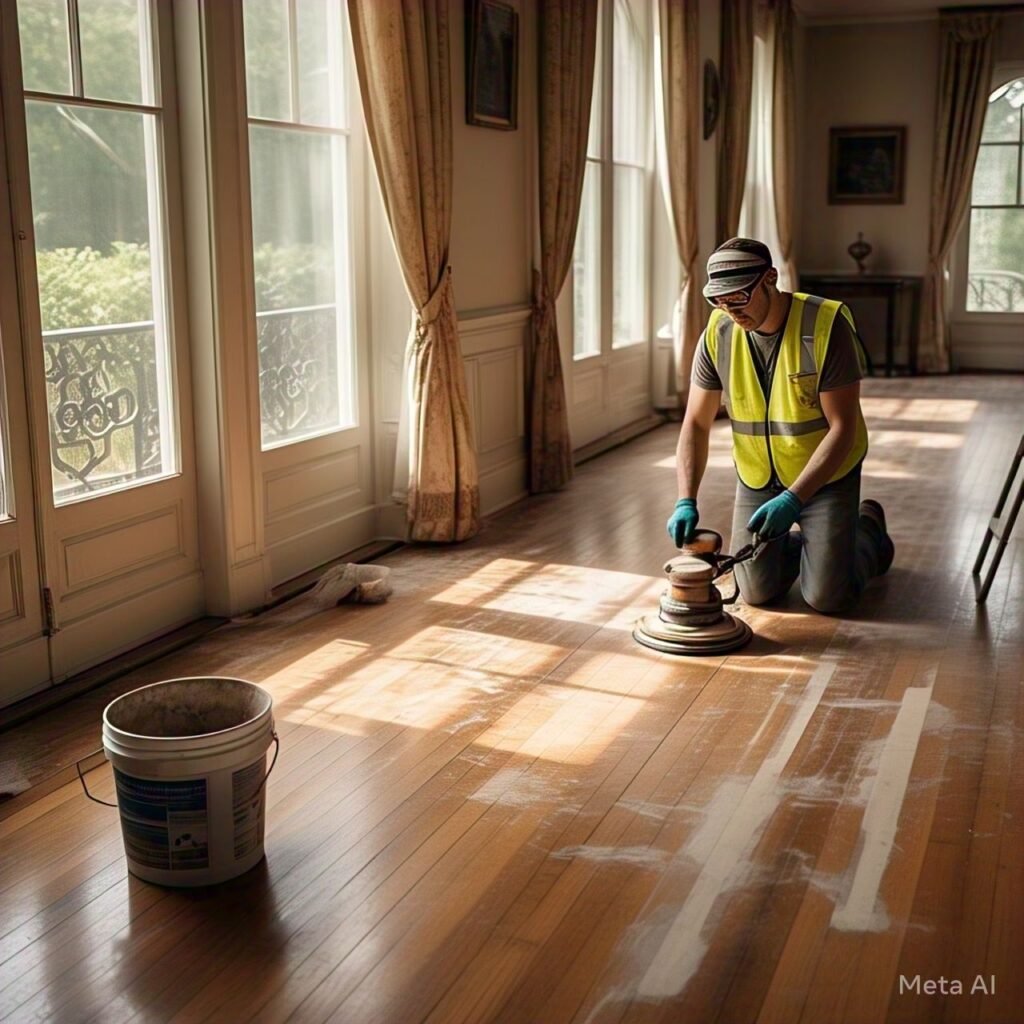Refinishing hardwood floors in the kitchen is one of the most effective ways to revitalize your home’s most frequently used space. Over time, kitchen floors endure spills, scratches, and heavy foot traffic, which can leave them looking worn and outdated. Refinishing not only restores their natural beauty but also adds a layer of protection to withstand future wear and tear. In this comprehensive guide, we’ll explore everything you need to know about refinishing hardwood floors in the kitchen, from preparation and execution to maintenance and cost-saving tips. Let’s get started.
Why Refinishing Hardwood Floors in Kitchen is a Smart Investment
The kitchen is often considered the heart of the home, and its floors take a beating. From dropped utensils to spilled liquids, hardwood floors in the kitchen are subjected to constant stress. Refinishing hardwood floors in the kitchen is a cost-effective solution that can transform the look and feel of your space without the need for a full replacement.
Refinishing offers several benefits:
- Enhanced Aesthetics: Restore the natural grain and color of your hardwood floors.
- Increased Durability: A fresh finish protects against scratches, stains, and moisture.
- Improved Home Value: Well-maintained hardwood floors are a selling point for potential buyers.
- Eco-Friendly Choice: Refinishing reduces waste compared to replacing floors entirely.
Whether your floors are scratched, faded, or simply outdated, refinishing hardwood floors in the kitchen can breathe new life into your home.
Assessing the Condition of Your Hardwood Floors
Before diving into refinishing hardwood floors in the kitchen, it’s essential to assess their current condition. Start by inspecting the floors for signs of damage, such as deep scratches, warping, or discoloration. Minor issues like surface scratches can often be fixed with sanding and refinishing, but severe damage may require professional intervention.
Here’s what to look for:
- Surface Scratches: These are common in high-traffic areas and can usually be sanded out.
- Deep Gouges: These may require wood filler or professional repair.
- Water Damage: Warping or discoloration from spills can indicate deeper issues.
- Worn Finish: If the finish is peeling or dull, it’s time for refinishing.
If your floors are in relatively good condition, refinishing hardwood floors in the kitchen can be a straightforward DIY project. However, if you notice significant damage, consulting a professional is recommended.
Tools and Materials Needed for Refinishing Hardwood Floors in Kitchen
Refinishing hardwood floors in the kitchen requires specific tools and materials to ensure a smooth and professional result. Here’s a checklist of what you’ll need:
- Drum Sander or Orbital Sander: For sanding the main floor area.
- Edger: For sanding tight corners and edges.
- Sandpaper: Coarse, medium, and fine grit for different stages of sanding.
- Wood Stain (Optional): To change or enhance the color of your floors.
- Polyurethane Finish: For sealing and protecting the floors.
- Paintbrushes or Applicators: For applying stain and finish.
- Safety Gear: Gloves, goggles, and a mask to protect against dust and fumes.
Having the right tools on hand will make the refinishing process more efficient and ensure a high-quality finish.
Preparing Your Kitchen for Refinishing
Proper preparation is key to successfully refinishing hardwood floors in the kitchen. Start by removing all furniture, rugs, and appliances from the room. Cover cabinets, countertops, and any remaining fixtures with plastic sheets to protect them from dust and debris.
Next, thoroughly clean the floors to remove dirt, grease, and grime. Any residue left on the surface can interfere with the refinishing process, so take the time to sweep, vacuum, and mop the floors. If you’re working in an older home, be cautious of lead-based paint or finishes, which may require special handling.

Sanding: The Foundation of Refinishing Hardwood Floors in Kitchen
Sanding is the most labor-intensive step in refinishing hardwood floors in the kitchen, but it’s also the most important. Sanding removes the old finish and smooths out imperfections, creating a clean surface for the new finish.
Here’s how to sand your floors effectively:
- Start with Coarse-Grit Sandpaper: Use a drum sander or orbital sander to remove the old finish and level the surface.
- Switch to Medium-Grit Sandpaper: This step smooths out any remaining imperfections.
- Finish with Fine-Grit Sandpaper: This creates a polished surface ready for staining or sealing.
Always sand in the direction of the wood grain to avoid scratches. After sanding, use an edger to tackle tight corners and edges that the sander can’t reach. Finally, vacuum and wipe down the floors to remove all dust before moving on to the next step.
Applying Stain to Refinish Hardwood Floors in Kitchen
If you want to change or enhance the color of your hardwood floors, applying a wood stain is the next step. Stains come in a variety of shades, from light natural tones to rich, dark hues. Choose a stain that complements your kitchen’s decor and test it on a small, inconspicuous area first.
To apply the stain:
- Use a brush or cloth to apply the stain evenly across the floor.
- Work in small sections to ensure consistent coverage.
- Wipe away excess stain with a clean cloth to prevent blotching.
- Allow the stain to dry completely before applying the finish.
Staining is optional, but it can add depth and character to your hardwood floors, making them a standout feature in your kitchen.
Sealing Your Floors with Polyurethane
Sealing is the final step in refinishing hardwood floors in the kitchen. A polyurethane finish provides a durable, protective layer that resists scratches, spills, and stains.
Here’s how to apply polyurethane:
- Use a brush or roller to apply the first coat evenly across the floor.
- Allow the first coat to dry according to the manufacturer’s instructions.
- Lightly sand the surface with fine-grit sandpaper to ensure proper adhesion for the next coat.
- Apply at least two to three coats for optimal protection.
Water-based polyurethane is a popular choice for kitchens because it dries quickly and emits fewer fumes than oil-based alternatives.
Maintaining Your Refinished Hardwood Floors
Once you’ve completed refinishing hardwood floors in the kitchen, proper maintenance is essential to keep them looking their best. Here are some tips:
- Clean Spills Immediately: Water and other liquids can damage hardwood floors if left unattended.
- Use Felt Pads: Place felt pads under furniture legs to prevent scratches.
- Sweep or Vacuum Regularly: Dirt and debris can scratch the finish over time.
- Avoid Harsh Cleaners: Use a pH-neutral cleaner specifically designed for hardwood floors.
With proper care, your refinished hardwood floors can last for decades, maintaining their beauty and functionality.
Common Mistakes to Avoid When Refinishing Hardwood Floors in Kitchen
Refinishing hardwood floors in the kitchen can be a rewarding project, but it’s easy to make mistakes if you’re not careful. Here are some common pitfalls to avoid:
- Skipping Preparation: Failing to clean or protect your kitchen can lead to a messy and uneven finish.
- Using the Wrong Sandpaper: Starting with fine-grit sandpaper won’t effectively remove the old finish.
- Applying Too Much Stain: Excess stain can result in a blotchy or uneven appearance.
- Rushing the Process: Allow adequate drying time between each step to ensure a professional-looking result.
When to Hire a Professional for Refinishing Hardwood Floors in Kitchen
While refinishing hardwood floors in the kitchen is a manageable DIY project for many homeowners, there are times when hiring a professional is the best option. If your floors have extensive damage, such as deep gouges or warping, a professional can assess whether refinishing is feasible or if replacement is necessary. Additionally, if you’re short on time or lack the necessary tools, a professional can ensure a high-quality finish.
Eco-Friendly Options for Refinishing Hardwood Floors in Kitchen
If you’re environmentally conscious, there are eco-friendly options for refinishing hardwood floors in the kitchen. Look for water-based polyurethane finishes, which emit fewer volatile organic compounds (VOCs) than oil-based alternatives. You can also choose stains and finishes made from natural ingredients, such as plant-based oils and waxes.
Cost of Refinishing Hardwood Floors in Kitchen
The cost of refinishing hardwood floors in the kitchen varies depending on factors like the size of the space, the condition of the floors, and whether you hire a professional. On average, DIY refinishing costs between
200and
200and500, while professional services can range from
600to
600to1,200. While the upfront cost may seem high, refinishing is a worthwhile investment that can save you money in the long run.
Frequently Asked Questions About Refinishing Hardwood Floors in Kitchen
1. How long does it take to refinish hardwood floors in the kitchen?
The process typically takes 2-3 days, including drying time between coats.
2. Can I refinish hardwood floors in the kitchen myself?
Yes, with the right tools and preparation, refinishing hardwood floors in the kitchen is a manageable DIY project.
3. How often should I refinish my hardwood floors?
Hardwood floors should be refinished every 7-10 years, depending on wear and tear.
4. What’s the difference between refinishing and recoating?
Refinishing involves sanding down the entire surface and applying a new finish, while recoating simply adds a new layer of finish without sanding.
Conclusion: Transform Your Kitchen with Refinished Hardwood Floors
Refinishing hardwood floors in the kitchen is a practical and cost-effective way to enhance the beauty and functionality of your space. By following the steps outlined in this guide, you can achieve professional-looking results that will last for years to come. Whether you tackle the project yourself or hire a professional, the effort is well worth it. So, roll up your sleeves and get ready to transform your kitchen with stunning refinished hardwood floors!
